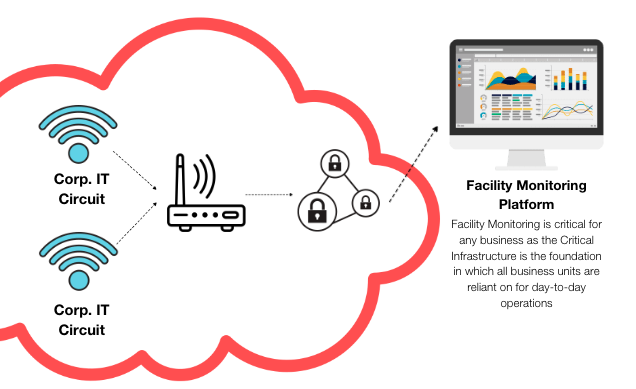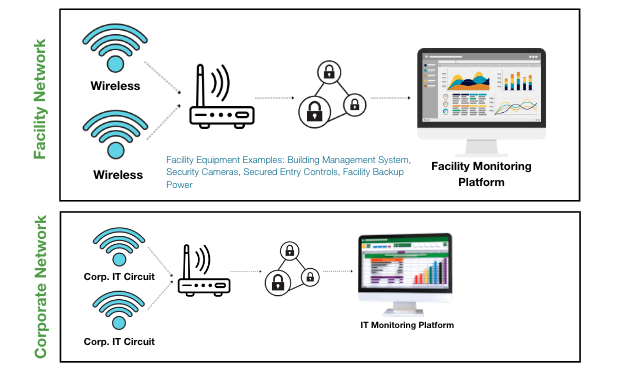

Are you tired of relying on your IT department to manage your network? Do you find yourself spending too much time trying to fix network issues or waiting for IT to respond? Does your critical equipment suffer from communication issues caused by IT updates and security scans? If you answered yes to any of these questions, you might benefit from the power of a private facilities network from PTI.
Typical Pain Points with Corporate Networks include:

Illustration of a typical corporate IT infrastructure where the facility’s network has to go through the IT network.
We work with multiple facility partners to create a completely separate network for the facilities team only. This private, secure network would be solely controlled by the facilities team, helping to prevent any monitoring failures for their critical equipment.

Illustration of the new private facilities network and private corporate network. Both are separate from each other.
A head of facilities within a corporation would be an ideal candidate. As the head of facilities, you’re responsible for monitoring equipment and executing responses when an issue occurs. However, having to work through the IT department often creates roadblocks that prevent you from doing your job. Especially with the critical nature of facility equipment, having a separate network for the facilities equipment ensures issues are handled immediately, the equipment is secure and removes the equipment from the corporate network in turn making the corporate network more secure.
The overall process of creating this separate facilities network is seamless from the viewpoint of the end user. As the facilities team, there is little information or work you will need to do to get this new network up and running. As your turnkey partner, we will bring in all hardware, set up all hardware, and connect all devices to the new network. Our team will be on-site to get your system up and running and will provide in-person training to you and your team so you know how to manage, access, and work with your new network.
Once the system is installed, our team will be your one point of contact for adds, changes, moves, or questions. This solution will remove a lot of network pain points that you are currently dealing with on a daily basis.
Talk with a member of our team today to learn about the power of a private facilities network.



Adds, moves, and changes are done within hours/day as opposed to weeks/months.
IT and Facilities teams can focus on their normal day-to-day duties and not lose time focusing on each other’s network problems.
Corporate outages/network changes will not affect the facility monitoring platform or network.



Facilities’ secured network will be completely separate from the IT network, making each more secure.
Facility teams take full responsibility and ownership of their private network. Managing their network, equipment, and systems fully on their own.
Single point of contact with our managed security service provider for issues, questions, and troubleshooting of your network.
To download the above resources, select the image icon. A new window will open and you will be able to print or save the PDF.
